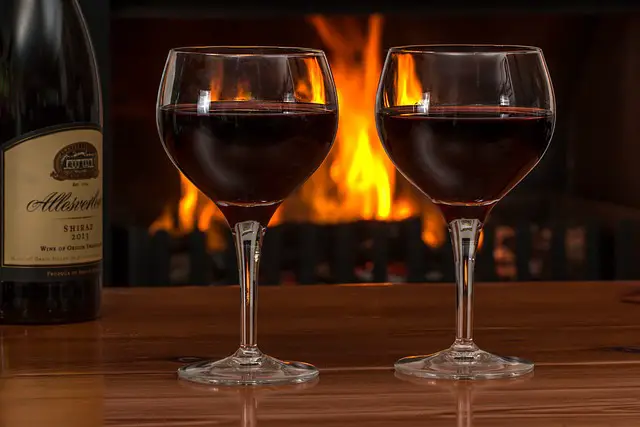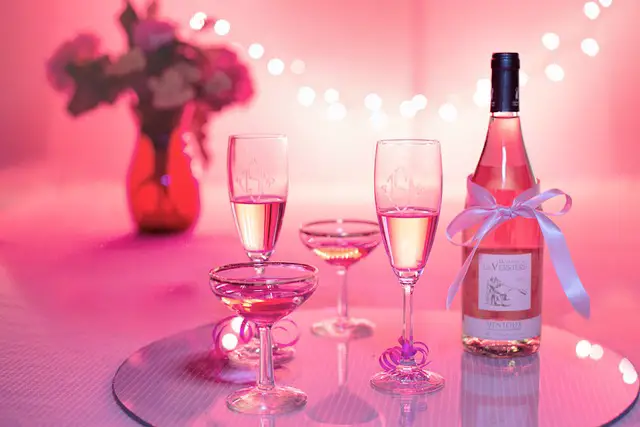If you’re a wine enthusiast who delights in a glass of red wine but struggles with how to store it properly after opening without a cork, fear not! We’ve got you covered. In this informative article, we’ll explore effective storage methods that will preserve the flavor and quality of your red wine without the need for a traditional cork. Whether you’re an occasional sipper or a connoisseur, join us as we delve into the world of red wine storage and discover the secrets that will ensure your favorite bottle stays fresh for longer periods. Get ready to uncork a treasure trove of knowledge on how to savor every sip, without worrying about the cork!
Obsah
- – Understanding the Importance of Proper Storage for Opened Red Wine
- – Exploring Alternative Methods for Sealing Red Wine Bottles Without a Cork
- Exploring Alternative Methods for Sealing Red Wine Bottles Without a Cork
- – Best Practices for Temperature and Humidity Control in Wine Storage
- – The Impact of Oxygen Exposure on Red Wine and How to Minimize It
- The Impact of Oxygen Exposure on Red Wine and How to Minimize It
- – Leveraging Vacuum Sealers to Preserve the Flavor and Aroma of Opened Red Wine
- Leveraging Vacuum Sealers to Preserve the Flavor and Aroma of Opened Red Wine
- – Exploring the Use of Wine Stoppers and Preservers for Long-Term Storage
- Exploring the Use of Wine Stoppers and Preservers for Long-Term Storage
- – Expert Tips on Refrigeration and Cellaring for Extended Wine Shelf Life
- Expert Tips on Refrigeration and Cellaring for Extended Wine Shelf Life
- – Safely Enjoying Stored Red Wine: Key Considerations and Recommendations
- Insights and Conclusions
– Understanding the Importance of Proper Storage for Opened Red Wine
The Importance of Proper Storage for Opened Red Wine
Once you’ve unsealed a bottle of delicious red wine, it’s crucial to understand the importance of proper storage to maintain its flavor and quality. Here are a few key reasons why you should pay attention to how you store your opened bottle:
- Preserving taste and aroma: Proper storage helps preserve the delicate flavors and aromas of red wine, allowing you to enjoy its full potential. Exposure to oxygen can lead to oxidation, resulting in a loss of fruity, vibrant notes and developing undesirable flavors.
- Preventing spoilage: By storing your opened red wine correctly, you can prevent spoilage caused by bacteria and other contaminants. The right conditions help inhibit the growth of harmful microorganisms that can turn your favorite bottle of wine into a disappointing experience.
- Extending shelf life: Implementing proper storage practices can significantly extend the shelf life of opened red wine. By minimizing exposure to light, heat, and air, you can maintain the wine’s freshness and savor it over multiple days or even weeks.
Remember, when it comes to storing opened red wine, consistency is key. Once opened, recork the bottle tightly or use a wine stopper to minimize oxygen exposure. Store the wine upright to limit the wine’s surface area and reduce the potential for oxidation. To further protect it, keep your opened red wine in a cool, dark place away from direct sunlight and temperature fluctuations. Following these simple guidelines will elevate your wine-drinking experience and ensure that each glass is as enjoyable as the first.
– Exploring Alternative Methods for Sealing Red Wine Bottles Without a Cork
Exploring Alternative Methods for Sealing Red Wine Bottles Without a Cork
When it comes to sealing red wine bottles, traditional corks have long been the go-to choice. However, the wine industry has been continuously innovating, providing alternative methods that offer convenience, maintain wine quality, and reduce the risk of cork taint. Let’s delve into some creative and effective solutions for sealing red wine bottles without using a cork:
Screw Caps
One popular alternative to corks is the use of screw caps. Originally associated with inexpensive wines, screw caps have gained recognition for their ability to preserve the integrity of the wine. They eliminate the risk of cork taint and allow for easy opening and resealing. Screw caps ensure an airtight seal, preventing oxidation and preserving the wine’s freshness. Moreover, screw caps are more convenient and cost-effective than corks, as they require no additional tools to open or reseal.
Glass Stoppers
Another ingenious solution for sealing red wine bottles is the use of glass stoppers. These elegant, reusable stoppers create a tight seal that effectively preserves the wine’s flavors and aromas. Crafted from high-quality glass, these stoppers are non-reactive, preventing any unwanted flavors from altering the wine. Moreover, the transparency of the glass stopper allows for a visually appealing presentation. While glass stoppers may require a bit more dexterity to remove, their effectiveness in preserving wine quality makes them a favored choice among many wine enthusiasts.
– Best Practices for Temperature and Humidity Control in Wine Storage
Proper temperature and humidity control is crucial for the preservation and aging of wine. Fluctuations in these factors can significantly impact the taste, aroma, and overall quality of the wine. To ensure the longevity of your precious collection, it is essential to follow these best practices:
- Temperature: Maintain a consistent temperature between 50°F (10°C) and 59°F (15°C). Avoid extreme variations, as they can affect the flavor and spoil the wine. Ideal storage temperature for most wines is around 55°F (13°C). Ensure that the temperature remains constant throughout the storage area, as variations within different parts of the wine cellar can lead to inconsistencies.
- Humidity: Preserve the right amount of moisture in the air to prevent the corks from drying out or developing mold. Aim for a humidity level between 50% and 70% to keep the labels intact and the corks moist. Use a hygrometer to monitor the humidity levels regularly, and consider investing in a humidifier or dehumidifier to adjust the moisture content accordingly.
Moreover, it is essential to avoid exposing the wine to direct sunlight or intense artificial light. Ultraviolet rays can deteriorate the wine, leading to premature aging and off-flavors. Place your wine collection in a dark area or use UV-filtered glass in your wine cellar to protect it from harmful light. Furthermore, minimize vibrations and movement around the storage area, as they can disturb the sediments in the wine and negatively affect its taste. Following these best practices will help maintain the integrity and quality of your wines, allowing you to enjoy them at their fullest potential.
– The Impact of Oxygen Exposure on Red Wine and How to Minimize It
The Impact of Oxygen Exposure on Red Wine and How to Minimize It
When it comes to red wine, oxygen exposure can have a significant impact on its flavor, aroma, and overall quality. While a little exposure can enhance the wine’s complexity, too much oxygen can lead to undesirable changes, such as oxidation. Oxidation can result in a loss of fruitiness and vibrant color, as well as the development of off-putting aromas, like vinegar or wet cardboard.
To ensure that your red wine remains at its best, it’s essential to minimize oxygen exposure. Here are a few tips to help you preserve the integrity of your prized bottle:
- Store wine horizontally: By storing your red wine bottles on their sides, you can keep the cork moist and tight, preventing excessive oxygen from entering the bottle.
- Use a wine preserver: Invest in a wine preserver that uses inert gases, such as argon or nitrogen, to create a protective layer above the wine, acting as a barrier against oxygen.
- Limit decanting time: While decanting can be beneficial for younger red wines, avoid excessive exposure to air. Pour the desired amount into a decanter, minimizing the contact between the remaining wine and oxygen.
- Refrigerate opened bottles: If you have leftover red wine, refrigerate it to slow down oxidation. Although this won’t entirely halt the process, it can prolong the wine’s drinkability.
By taking these steps, you can savor your red wines at their fullest potential, ensuring that each glass is a delightful experience. Remember, a little precaution goes a long way in preserving the exquisite flavors and aromas that make red wine truly exceptional.
– Leveraging Vacuum Sealers to Preserve the Flavor and Aroma of Opened Red Wine
Leveraging Vacuum Sealers to Preserve the Flavor and Aroma of Opened Red Wine
There is nothing quite like savoring a glass of fine red wine, but sometimes, we don’t finish the entire bottle in one sitting. However, fear not! Vacuum sealers offer a practical solution to ensure that your opened red wine stays fresh and retains its delightful flavors and enticing aromas for longer periods.
So, how does a vacuum sealer work its magic? By removing the excess air from the bottle, it significantly slows down the oxidation process that can compromise the wine’s taste and bouquet. By harnessing the power of vacuum technology, these ingenious devices create an airtight seal that acts as a protective shield for your wine, effectively preserving its quality until the next pour. Let’s explore some compelling reasons why vacuum sealers have become an indispensable tool for wine enthusiasts:
- Extended longevity: Vacuum sealers can prolong the life of your opened red wine by keeping it fresh for up to a week or sometimes even longer, depending on the wine’s characteristics. No more guilt about not finishing a bottle in one evening!
- Convenience: With a vacuum sealer, you can enjoy a glass of wine without the pressure of needing to finish the entire bottle. It allows you to savor your wine at your own pace, effortlessly preserving the remainder for future enjoyment.
- Cost-effective: By preventing your opened red wine from spoiling, vacuum sealers can help you save money in the long run. No more pouring down the drain half-full bottles that have lost their luster.
- Enhanced taste: When using a vacuum sealer, you can genuinely appreciate your red wine’s original flavors and enticing aromas, as they remain intact for an extended period. It’s like having an encore performance of your favorite wine!
So, whether you indulge in a glass of red wine every night or occasionally, a vacuum sealer is an invaluable tool for preserving the delectable flavors and delightful aromas of your opened bottles. Don’t let your wine lose its allure; leverage the power of vacuum sealing and enjoy every sip as if it were the first!
– Exploring the Use of Wine Stoppers and Preservers for Long-Term Storage
Exploring the Use of Wine Stoppers and Preservers for Long-Term Storage
Properly storing wine is essential to maintain its flavor and quality over time. Whether you’re a casual wine enthusiast or a serious collector, investing in the right wine stoppers and preservers can make a significant difference in preserving your favorite bottles for the long haul.
Wine stoppers serve as a barrier between the air and the wine, preventing oxidation and spoilage. By sealing the bottle tightly, they help maintain the wine’s aroma, taste, and overall character. There are various types of stoppers available, including cork, synthetic, and glass. Cork stoppers are the traditional choice, favored for their ability to allow wine to breathe slightly while still providing a snug fit. Synthetic stoppers, made from materials like rubber or silicone, offer reliable seals and are often reusable. Glass stoppers can add a touch of elegance to wine bottles while maintaining an airtight seal.
In addition to stoppers, wine preservers can help prolong the lifespan of opened bottles. These handy devices work by removing oxygen from the bottle, slowing down the oxidation process that can negatively impact the wine’s quality. Vacuum pumps are a popular choice, allowing you to create a vacuum within the bottle and effectively limiting the contact between the wine and oxygen. Another option is inert gas sprays or systems that replace the oxygen in the bottle with a harmless gas like argon. These methods are particularly useful for preserving wines that need a longer aging period after opening.
When it comes to long-term storage, investing in quality wine stoppers and preservers is a wise decision. By utilizing appropriate methods for sealing and preserving your bottles, you can safeguard the flavors and characteristics that make each wine unique. So, whether you’re planning to enjoy a glass in the near future or saving a special bottle for a special occasion, proper wine storage can ensure that your wine is always at its best.
– Expert Tips on Refrigeration and Cellaring for Extended Wine Shelf Life
Expert Tips on Refrigeration and Cellaring for Extended Wine Shelf Life
When it comes to preserving the quality and longevity of your prized wine collection, proper storage is of utmost importance. Whether you’re a casual wine enthusiast or a seasoned connoisseur, here are some expert tips on refrigeration and cellaring techniques that will help maximize the shelf life of your favorite bottles.
* Optimal Temperature: Maintaining the right temperature is crucial in preserving wine quality. For short-term storage, refrigeration at around 50°F (10°C) is preferred. However, for extended cellaring, a consistent temperature between 55°F and 58°F (13°C and 14°C) is ideal. Avoid fluctuations as they can negatively impact the wine’s flavor and consistency.
* The Darkness Factor: Light can be a wine’s enemy, as it can cause chemical reactions that degrade the taste. Keep your wine bottles away from direct sunlight or fluorescent light sources. Consider storing them in a dark cellar or invest in storage solutions that offer UV protection.
* Humidity Control: Proper humidity levels are vital to prevent corks from drying out or mold formation. Aim for a relative humidity of 60-70% to ensure the cork maintains a tight seal without becoming too moist. Use a hygrometer to monitor humidity levels and consider investing in a humidifier or moisture control system if needed.
* Stability and Positioning: Wine bottles should be stored horizontally to keep the cork in contact with the wine, preventing it from drying out and allowing oxygen to enter. Additionally, maintaining stability is essential to avoid disturbing any sediment that may have formed. Invest in sturdy wine racks or cellar storage systems that offer secure and vibration-free storage.
* Limited Vibrations: Vibrations can negatively impact the aging process and taste of wine. Ensure your cellar or storage area is free from excessive vibrations caused by nearby appliances or heavy traffic. Consider using vibration-absorbing materials such as cork or foam padding to minimize any potential disturbances.
* Keep it Odorless: Wine, being a delicate beverage, can absorb odors easily. Avoid storing wine near strong-smelling substances or chemicals, as it can alter the wine’s aroma and taste. Choose a dedicated storage area away from the kitchen, pantry, or any other area with potent odors.
By following these expert tips on refrigeration and cellaring, you’ll be well on your way to preserving the integrity and flavor of your cherished wine collection. Proper storage conditions are key to enjoying your bottles for years to come, ensuring every sip is as delightful as the first.
– Safely Enjoying Stored Red Wine: Key Considerations and Recommendations
Proper Storage Temperature: When it comes to enjoying stored red wine, one key consideration is the temperature at which it is stored. The ideal temperature for storing red wine is between 55°F (13°C) and 65°F (18°C). Exposing the wine to temperatures outside of this range can negatively impact its taste, aroma, and overall quality. Therefore, it is essential to store your red wine in a cool, dark place to maintain its integrity.
Adequate Humidity Levels: In addition to temperature, humidity levels play a crucial role in preserving the quality of stored red wine. Ideally, the humidity in the storage area should be maintained between 50% and 70%. Insufficient humidity can cause corks to dry out, resulting in oxidation and potentially ruining the wine. On the other hand, excessive humidity can cause mold and degrade the labels. To ensure your stored red wine remains in optimal condition, invest in a hygrometer to measure and regulate humidity levels.
Insights and Conclusions
In conclusion, storing red wine without a cork is possible using alternatives like vacuum pumps or inert gas sprays. By following these effective storage methods, you can enjoy your wine for a longer period without compromising its quality. Cheers!









